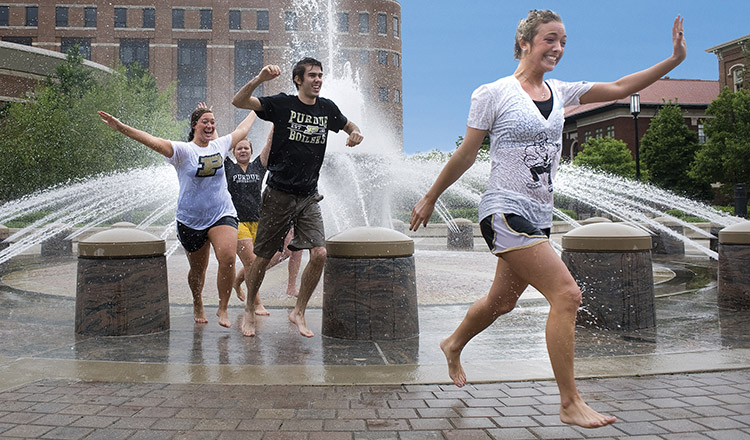Fountain runs are a rite of passage for many Purdue students. During Boiler Gold Rush, they serve as an introduction to the invigorating pursuits that lay ahead. Upon graduation, they embody a feeling of triumph and achievement. Often described as the quintessential Purdue experience, fountain runs have evolved over the years due to the ever-changing campus landscape.
In 1989, the Class of 1939 Water Sculpture was dedicated during Homecoming. It was designed by Robert Youngman and originally intended to be more decorative than interactive, but Youngman and university staff were pleasantly surprised when students began employing it as a means of cooling off on hot days. Also referred to as the Engineering Fountain, this iconic symbol of Purdue is one of the most popular fountains. In fact, its popularity led to what some consider an unfortunate eyesore — a metal cylinder enclosing the main water jets. The cylinder was added in 2001 after administrators became concerned by a number of reported injuries.
Fountain runs as they are known today came into being with the Purdue Mall sculpture, but prior to its installation, another generation of students enjoyed a different fountain outside Hovde Hall. Loeb Fountain, constructed in 1959, was a gift from local residents Bert and June Loeb. It served as the centerpiece of campus, where students would gather between classes and wade around in humid weather. At night, the fountain was favored for a more passionate activity — romantically inclined students would attempt to kiss through its cycle of colored lights. Especially rambunctious students participated in “soaping” the fountain, in which soap, and occasionally Jell-O, was added to the water to create a foamy mess. After its removal in the late 1980s, the fountain resided in a warehouse for several years. With the addition of a pedestrian mall adjacent to Beering Hall, Loeb Fountain found a new home in Founders Park in 1994. The reservoir of the fountain was removed, and 24 limestone bollards with water jets were installed, allowing for fountain-running ease. Although Loeb Fountain and the Class of 1939 Water Sculpture are the most convenient water features to run through today, three other fountains are periodically included in runs.
The Lions Fountain, a gift from the class of 1903, is located near Memorial Mall and provides fresh drinking water for thirsty runners. Memorial Fountain, located next to John Purdue’s grave on Memorial Mall, was donated by the class of 1894. Jumping in this fountain would have once been quite fishy — the Department of Animal Sciences formerly kept it stocked with goldfish. Reportedly, a piranha, bluegill, crappie, and carp found a short-lived home in the fountain as well. Due to its location in Discovery Park, McGinley Fountain, featuring Purdue imagery and a design inspired by the Fibonacci sequence, is perhaps the least utilized by fountain-run enthusiasts.
While the fountains themselves are set in stone, the proper way to experience a fountain run is not. Some begin at the Class of 1939 Water Sculpture, head south to the Lions Fountain, veer southwest to Memorial Fountain, and end at Loeb Fountain. Others continue to McGinley Fountain and then repeat the entire sequence in reverse. Some stop at Sinninger Pond, and others insist runners must race around each fountain three times. Regardless of the method, the shimmering waters of Purdue’s fountains continue to entice sweltering students and symbolize the cycles of collegiate life.

